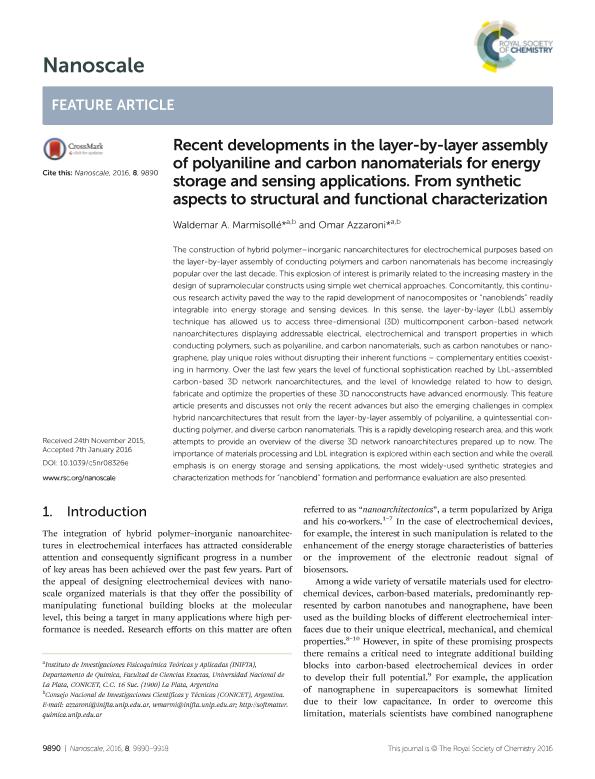Mostrar el registro sencillo del ítem
dc.contributor.author
Marmisollé, Waldemar Alejandro

dc.contributor.author
Azzaroni, Omar

dc.date.available
2018-10-11T15:01:56Z
dc.date.issued
2016-05
dc.identifier.citation
Marmisollé, Waldemar Alejandro; Azzaroni, Omar; Recent developments in the layer-by-layer assembly of polyaniline and carbon nanomaterials for energy storage and sensing applications. from synthetic aspects to structural and functional characterization; Royal Society of Chemistry; Nanoscale; 8; 19; 5-2016; 9890-9918
dc.identifier.issn
2040-3372
dc.identifier.uri
http://hdl.handle.net/11336/62186
dc.description.abstract
The construction of hybrid polymer-inorganic nanoarchitectures for electrochemical purposes based on the layer-by-layer assembly of conducting polymers and carbon nanomaterials has become increasingly popular over the last decade. This explosion of interest is primarily related to the increasing mastery in the design of supramolecular constructs using simple wet chemical approaches. Concomitantly, this continuous research activity paved the way to the rapid development of nanocomposites or "nanoblends" readily integrable into energy storage and sensing devices. In this sense, the layer-by-layer (LbL) assembly technique has allowed us to access three-dimensional (3D) multicomponent carbon-based network nanoarchitectures displaying addressable electrical, electrochemical and transport properties in which conducting polymers, such as polyaniline, and carbon nanomaterials, such as carbon nanotubes or nanographene, play unique roles without disrupting their inherent functions-complementary entities coexisting in harmony. Over the last few years the level of functional sophistication reached by LbL-Assembled carbon-based 3D network nanoarchitectures, and the level of knowledge related to how to design, fabricate and optimize the properties of these 3D nanoconstructs have advanced enormously. This feature article presents and discusses not only the recent advances but also the emerging challenges in complex hybrid nanoarchitectures that result from the layer-by-layer assembly of polyaniline, a quintessential conducting polymer, and diverse carbon nanomaterials. This is a rapidly developing research area, and this work attempts to provide an overview of the diverse 3D network nanoarchitectures prepared up to now. The importance of materials processing and LbL integration is explored within each section and while the overall emphasis is on energy storage and sensing applications, the most widely-used synthetic strategies and characterization methods for "nanoblend" formation and performance evaluation are also presented.
dc.format
application/pdf
dc.language.iso
eng
dc.publisher
Royal Society of Chemistry

dc.rights
info:eu-repo/semantics/openAccess
dc.rights.uri
https://creativecommons.org/licenses/by-nc-sa/2.5/ar/
dc.subject
Nanographene
dc.subject
Carbon Nanotubes
dc.subject
Conducting Polymers
dc.subject
Polyaniline
dc.subject.classification
Otras Ciencias Químicas

dc.subject.classification
Ciencias Químicas

dc.subject.classification
CIENCIAS NATURALES Y EXACTAS

dc.title
Recent developments in the layer-by-layer assembly of polyaniline and carbon nanomaterials for energy storage and sensing applications. from synthetic aspects to structural and functional characterization
dc.type
info:eu-repo/semantics/article
dc.type
info:ar-repo/semantics/artículo
dc.type
info:eu-repo/semantics/publishedVersion
dc.date.updated
2018-09-24T13:52:20Z
dc.journal.volume
8
dc.journal.number
19
dc.journal.pagination
9890-9918
dc.journal.pais
Reino Unido

dc.journal.ciudad
Cambridge
dc.description.fil
Fil: Marmisollé, Waldemar Alejandro. Consejo Nacional de Investigaciones Científicas y Técnicas. Centro Científico Tecnológico Conicet - La Plata. Instituto de Investigaciones Fisicoquímicas Teóricas y Aplicadas. Universidad Nacional de La Plata. Facultad de Ciencias Exactas. Instituto de Investigaciones Fisicoquímicas Teóricas y Aplicadas; Argentina
dc.description.fil
Fil: Azzaroni, Omar. Consejo Nacional de Investigaciones Científicas y Técnicas. Centro Científico Tecnológico Conicet - La Plata. Instituto de Investigaciones Fisicoquímicas Teóricas y Aplicadas. Universidad Nacional de La Plata. Facultad de Ciencias Exactas. Instituto de Investigaciones Fisicoquímicas Teóricas y Aplicadas; Argentina
dc.journal.title
Nanoscale
dc.relation.alternativeid
info:eu-repo/semantics/altIdentifier/doi/https://dx.doi.org/10.1039/C5NR08326E
dc.relation.alternativeid
info:eu-repo/semantics/altIdentifier/url/https://pubs.rsc.org/en/Content/ArticleLanding/2016/NR/C5NR08326E
Archivos asociados
